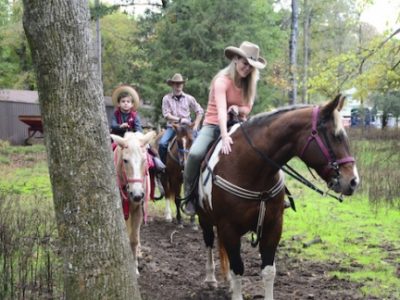Call them squirrels or call them bushytails, one thing is for certain, these elusive creatures offer great hunting action and few hunting experiences can compete with the “Squirrel Challenge” on the Honobia Creek.
While some hunters assume that squirrel hunting is not worth their time and effort, true hunters know the many benefits associated with hunting the elusive bushytail. Squirrel hunting is a good way to improve one’s shooting accuracy and stalking skills. Compared to hunting deer, turkey, or waterfowl, the accessories needed to bag a few bushytails for the dinner table is far less expensive. Hunting the bushytail also provides a great opportunity to head out to the woods and enjoy the outdoors. Perhaps the greatest benefit the squirrel season offers is the chance for experienced hunters to introduce a young hunter to the sport. There is no better way to get a young person hooked on hunting than by having them harvest a few squirrels their first time out.
Oklahoma has two species of squirrels that are legal to hunt: the eastern fox squirrel and the eastern gray squirrel. Both the fox squirrel and gray squirrel are common on the Honobia Creek and Three Rivers Wildlife Management Areas (WMAs), but the gray squirrel is more abundant. Knowing where and when to find these squirrels and how to hunt them is the key to a successful hunt. Oklahoma’s squirrel season usually runs from May 15 through January 31 each year, but be sure to obtain a copy of the Oklahoma Hunting Guide to check the season dates and bag limits.
Both fox squirrels and gray squirrels can be found in almost any woodland forest, especially oak-hickory forests. Both squirrels diet on a mixture of acorns, hickory nuts, insects, berries, seeds, buds, and bark. Hunting bushytails in the spring is an added adventure because acorns and other nuts from the previous year have all been consumed and the crop for the current year is just starting to grow. Spring and summer squirrel hunters typically must cover more ground to find bushytails because squirrels don’t have a favorite food resource to key in on.
Instead of sitting still and hunting around food sources, a successful spring squirrel hunt is often achieved by stalking. Moving through the woods keeping your eyes and ears open is the key. Many times a squirrel can be seen jumping from one tree to the next, bouncing tree limbs as they go, and the hunter can quietly move in for a shot. Squirrels often bark at the presence of danger and by doing so they’ll give away their position. Using a commercially available squirrel whistle which mimics the cry of a wounded squirrel can also bring squirrels closer. Often, a frightened squirrel will climb a tree and flatten their bodies along a limb or position themselves on the opposite side of the tree trunk from the hunter. With a little patience the bushytail will often show himself. Hunting in pairs or having a good squirrel dog can also greatly improve the odds of both finding squirrels and pushing them out of their hiding spots. Many a squirrel has been harvested by having one hunter walk around a tree while a second hunter watches for the squirrel to circle around the tree trunk and present a shot.
Whether hunting fox or gray squirrels, knowing when to find them is also important. Fox squirrels aren’t always considered early risers, especially during cold mornings when they may not leave the nest until noon. Gray squirrels are most active during the early morning and late evening hours and are often seen on the forest floor during this time. Look for squirrels scampering across the forest floor or perched on a limb near the trunk of a tree. Locating potential nest cavities is also helpful in locating squirrels. The presence of old pileated woodpecker nests and leaf nests are a good indicator that squirrels may be in the area. As winter approaches, many of the mast producing trees such as hickories and oaks have had their nuts fall to the forest floor. With the tree canopy nearly void of nuts and fruits, squirrels spend much of their time harvesting food from the forest floor or burying their nuts and fruits for use later in winter.
The Honobia Creek and Three Rivers Wildlife Management Areas offer some great squirrel hunting opportunities. Bottomland hardwood areas along the Little River and Glover River systems as well as their tributaries are great places to encounter prime squirrel habitat. Maps of these two WMAs are available by visiting www.wildlifedepartment.com. As a reminder, accessing the Honobia Creek and Three Rivers WMAs for any type of recreation does require each person to purchase a Land Access Fee permit. The permit, $40 for Oklahoma residents between the ages of 18 and 64 and $85 for nonresidents (no age exemptions for nonresidents), is good for one calendar year and is sold at all locations in Oklahoma that sell hunting and fishing licenses. All revenue from each Land Access Fee permit sold goes not only toward the management of the WMAs, but also to pay the timber companies an annual lease fee to help keep the WMAs open for the public to enjoy.
The “squirrel challenge” is harvesting one gray squirrel and one fox squirrel in one day’s hunt. Are you up for the “squirrel challenge?” Give it a try on the Honobia Creek and Three Rivers WMAs, the action won’t disappoint.








